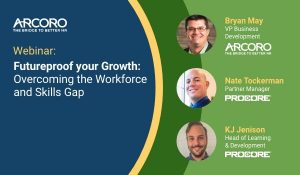
This special post was contributed by Chad Mathias, Arcoro’s Vice-President Channels & Strategic Alliances
Construction companies across the industry are struggling to find and retain workers. According to the Associated General Contractors of America (AGC) 2021 construction outlook survey:
- 54% of companies are reporting challenges recruiting workers
- 40% state worker quality was the number one challenge facing their business
- 43% identify workforce shortage as their number one challenge
So, what happened to all the skilled construction talent? A mix of contributing factors including:
- The global pandemic
- An aging population
- Decreasing workforce participation
- Increasing turnover
- Competition
According to reports, nearly 9.4 million jobs were lost during the pandemic and it’s estimated that at least 975,000 of those jobs were in construction, likely due to the pandemic forcing some workers into early retirement or another industry altogether.
“Our aging workforce is one of the biggest challenges facing our industry,” says Brian May, Arcoro HR Management Expert. “The pandemic really sped up the departure of the Baby Boomers, even without the pandemic. We’re seeing over 10,000 of the 81 million Baby Boomers retiring from the US workforce each day.”
As Baby Boomers represent 41% of the current construction workforce, that’s a problem. It’s estimated that the remaining boomers will retire within the next 10 years which will leave a significant gap in the talent pool. So younger generations will take their place, right? Not so fast. There aren’t enough people coming into the industry to replace Baby Boomers. According to AGC, construction businesses will need to hire 430,000 workers still this year and a million more over the next two years in order to keep up with demand.
The construction industry needs to also hire workers that can adapt to changing technology and perform safely and effectively on job sites. Learning and development can provide solutions to workforce issues.
Create a Pipeline of Talent
Creating a pipeline of talent comes down to recruiting both externally and internally. Talent managers help identify the right people and development opportunities necessary to meet and overcome current and future challenges.
- External recruiting: Use the open market to identify talent through your website, social media platforms, educator or community groups, faith-based and veterans’ organizations or other underutilized groups. The one caveat of external recruiting is when you find people in the open market, they may not have the skills to perform safely and successfully.
- Internal recruiting: Internal recruiters can find ways to index key skills of your current employees, identifying those that are ready to take on the next challenge if given the proper training to be successful.
- Talented brand managers: These are your team members who are responsible for employee engagement and retention. Brand managers focus on your internal branding image, ensuring you deliver the employee experience your team members expect, helping to drive engagement, keeping the talent pipeline full and allowing for future employee development.
To develop your pipeline, you need to create an internal talent marketplace to provide employees with alternative career pathways and internal mobility. This means construction companies need to be in tune with future projects, new skills and the succession of key workers as they retire or transition into new roles.
Create a Strong Learning Plan
Strong Learning Plans are the foundation for both employee and organizational success. They demonstrate your commitment to employees and create engagement, endearment and loyalty to the organization. The more you retain your team members, the greater relief you can provide to the front end of the recruiting process.
A strong learning plan starts with a solid foundation that includes modern talent development. Learning and Development (L&D) has come a long way in a short amount of time. Today it consists of:
- Workforce management like compliance training
- Accessibility to meet employees where they are
- Efficiency to manage and track data
- Development of soft skills like coaching, mentoring, having difficult conversations, motivating and inspiring your people
Successful learning plans can consist of online, instructor-led classes, reviews, documents, meetings and other tasks. They can help your new hires prepare for a task ahead, they can help an employee get better in their current role or prepare an employee for future roles.
“Learning plans become a foundation on how successful employee experience can be, and they’re critical for how we overcome current and future workforce shortages,” says KJ Jenison, Head of Learning and Development for Procore.
Learning plans are used for new hire onboarding, career progression and annual compliance training.
“A big benefit of learning plans is that they drive commitment through two-way communication,” explains Jenison. “Ownership and accountability happen on both sides, and that increases the probability of the plan being successful, and the employee being more engaged.”
A strong learning and development strategy can position your company to compete for new business and keep costs down. It also gives your employees increased confidence and job satisfaction, further bolstering retention and company loyalty. According to LinkedIn Workplace Learning Report, 94% of employees surveyed would stay longer with a company that’s willing to invest in their professional development.
Measure the Success of Your L&D
Aside from training, proper evaluations of your L&D can give your organization the analytics necessary to identify trends, opportunities and successors. The documentation you can get out of a strong L&D system also supports risk mitigation and compliance while at the same time preparing you to compete for more business in the future.
“Until you take a data-centric approach, and adjust your L&D based on what the data is telling you, you won’t be able to maximize your ability with your talent,” says Jenison.
Documentation and reporting of L&D offers many benefits for companies including:
- Risk Reduction
- Jobsite compliance
- Workforce Allocation
- Mentorship
- Competing for Business
Companies that document L&D efforts, specifically with compliance, reduce risk on the job site. This also allows for easier workforce allocation when you can understand what skills your people have and where they can contribute more if given the right learning plan, work or mentorship. Your team members will be better prepared for the challenges ahead. And training metrics, licenses, certifications and employee experience can be used to bolster bids and compete for more business.
To get even more insight into this topic, view our webinar. You’ll learn more from the experts at Arcoro and Procore that will help you overcome the workforce skills gap.

 To get even more insight into this topic, view our
To get even more insight into this topic, view our 


